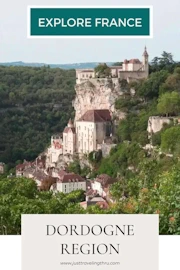by Celeste Lipford and Terry Lipford - last updated on 10/8/2025

Since we were renting a VRBO apartment in Amboise, a visit to the Château d'Amboise was a simple task. There is a public (payant type) parking lot next to the Loire River and across the street from the Château. There is also curb-side parking on route D-751 that parallels the river, but those parking spaces go quickly.
Originally constructed in the 15th century, Château d'Amboise played a significant role in the French Renaissance and was a favored residence of several French kings, including Charles VIII and Louis XII. Its unique blend of Gothic and Renaissance architectural elements reflects the transition from the medieval to the modern era.
One of the most notable features of the château is the Saint-Hubert Chapel, where the great artist and polymath, Leonardo da Vinci, is said to be buried. Leonardo spent his final years in Amboise under the patronage of King Francis I, leaving behind a legacy of art and innovation. Leonardo spent his final three years in France, and died in 1519 at age 67 in the Loire Valley. His chateau, the brick-and-marble Clos Lucé, is the artist's only known residence and workplace that is still standing.
Visitors can explore the château's ornate rooms, including the beautifully restored royal apartments, and take in the breathtaking views from its terraces. The serene landscaped gardens offer a peaceful retreat, making Château Royal d'Amboise a must-visit destination for history enthusiasts and lovers of architectural beauty.
The story of this chateau begins in the 10th century, a time of conflict and uncertainty. A humble fort, strategically placed to guard a crucial river crossing, marked the castle's first iteration. Over the next few centuries, the fortress changed hands several times, witnessing the rise and fall of local lords.
The Count of Anjou built the castle on the promontory, surveying the Loire River, as a defence strategy.
The 15th century marked a turning point. The French crown, under the reign of King Charles VIII, seized the castle in 1434. Charles VIII, a visionary and artistic monarch, embarked on a grand transformation. The utilitarian fortress was to become a magnificent royal residence, a testament to France's growing power and cultural ambition.
Charles VIII ushered in the era of Château Royal d'Amboise's architectural splendor. He called upon Italian master masons, bringing the burgeoning influence of the Renaissance to the Loire Valley. The castle's design embraced the late Gothic Flamboyant style, incorporating intricate details and soaring towers. This fusion of French and Italian aesthetics resulted in a unique architectural masterpiece.
Charles VIII's successor, Francis I, continued the castle's evolution. He further embellished the interiors, creating a luxurious and sophisticated environment. The allure of the transformed Château Royal d'Amboise extended beyond its walls. It became a magnet for artists and intellectuals, fostering a vibrant cultural scene. Leonardo da Vinci, the quintessential Renaissance man, spent his final years residing nearby, a testament to the intellectual ferment fostered by the royal court.
While Château Royal d'Amboise eventually yielded its position as the primary royal residence in the 16th century, its legacy endures. It stands as a magnificent symbol of artistic innovation and royal patronage.
Yes, you can get to Château Royal d’Amboise by driving, taking a full day bus tour or taking a train from Paris;
By Train: From the Paris Gare Montparnasse take a TGV to the Tours Gare Saint-Pierre-des-Corps station, then a TER from Tours to the Gare d'Amboise. You could also consider riding the INTERCITES from the Paris Austerlitz station to the Gare d'Amboise.
By Car: 226 kilometers via the A-10 through Orleans, follow A-10 to the D-31 and D-751 to Place Michel Debré in Amboise.
By Bus tour:
Either Viator or Get Your Guide may have bus tours that you can investigate.
The following list contains links to all of our other French Destinations & Information Pages, click any link to go to that page.
Note: All images featured on this page are the exclusive property of Just Traveling Thru, LLC, unless otherwise stated. When images from external sources are used, full credit is given to the original creator, along with a link to the specified license or usage terms. We are committed to respecting copyright and intellectual property rights, ensuring that all third-party images are properly attributed. If you have any questions regarding image ownership or usage rights, please feel free to contact us.
Affiliate Links: We may earn a commission if you make a purchase through one of our affiliate links. This helps support our travel content — thank you!
Content: To review any of our content, make suggestions and/or comments, please click the "About" menu link at the top of this page. You will find our "Contact Us" link on that drop-down menu.